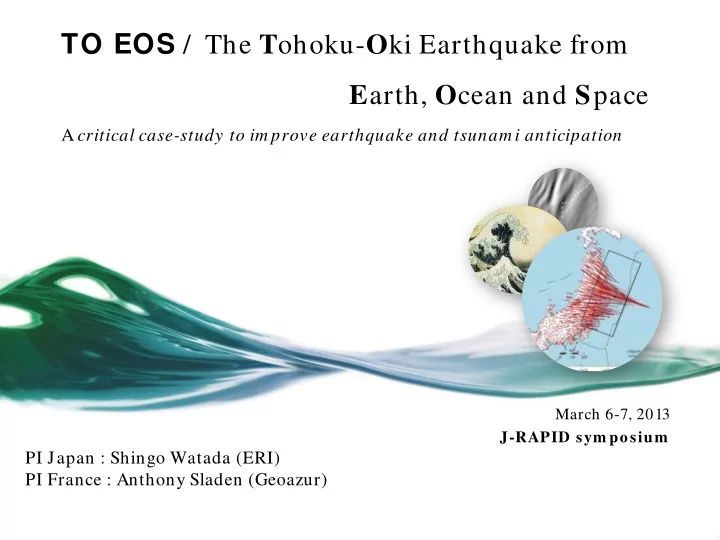

TO EOS / The T ohoku- O ki Earthquake from E arth, O cean and S pace A critical case-study to im prove earthquake and tsunam i anticipation March 6-7, 2013 J-RAPID sym posium PI Japan : Shingo Watada (ERI) PI France : Anthony Sladen (Geoazur)
TO EOS , an joint ANR-JST project Anthony Sladen Shingo Watada Geoazur, Sophia-Ant. ERI, Tokyo T.Yahagi, L.Rolland, E.Astafyeva, P.Bosser, B.Delouis, Ph.Lognonné, O.Cavalié, G.Occhipinti, A.Kherani, P. Coisson, M.Vallée, H.Hebert, M.Vergnolle,
Motivation Tsunami hit the Sanriku-coast 30 min after the earthquake, Atm ospheric waves from the tsunami source region arrived on land 6 min after the earthquake, Same waves propagated upward marked a ionospheric disturbance signature 7 min after the earthquake. What is the potential of these signals for early-w arning?
The atmospheric waves
Atmospheric boundary waves excited by the tsunami generation related to the 2011 great Tohoku ‐ Oki earthquake Geophysical Research Letters Volume 38, Issue 7, L00G18, 1 NOV 2011 DOI: 10.1029/ 2011GL049146 http:/ / onlinelibrary.wiley.com/ doi/ 10.1029/ 2011GL049146/ full#grl28542-fig-0006
Waveform is preserved after a long distance of propagation with little dispersion. z
Atm ospheric boundary waves excited by the tsunam i generation related to the 20 11 great Tohoku ‐ Oki earthquake Geophysical Research Letters Volume 38, Issue 7, L00G18, 1 NOV 2011 DOI: 10.1029/ 2011GL049146 http:/ / onlinelibrary.wiley.com/ doi/ 10.1029/ 2011GL049146/ full#grl28542-fig-0005
Tsunam i w aveform s Air waves hit the coast
The ionospheric waves
The ionosphere is sensitive to the details of the seismic source TO_EOS source model Ionospheric observation Based on the inversion of less 10min after T 0 seismology, geodesy and tsunami data Modeling in preparation (Bletery et al., in prep.) ( Rolland et al., in prep)
The ionosphere is sensitive to the details of the seismic source Complexity of slip distribution imaged from the ionosphere? (from 500 to 570 s. after the earthquake initiation) Correspondence with source models Astafyeva et al., Geophys. Res. Lett . , 2011 Astafyeva et al. , JGR-Space Science , in prep.
The ionosphere is sensitive to the details of the seismic source Ionospheric perturbations to estimate the magnitude or sea-floor deformation (even more critical for tsunami estimation) Astafyeva et al., Geophys. Res. Lett ., submitted
Perspectives for the ionospheric observations Radio occultation: GPS receiver on a satellite at low altitude (COSMIC satellites) First tsunami gravity wave detection in ionospheric radio occultation data, Provides vertical structure of ionosphere, P.Coïsson et al. Geophys. Res. Lett. , in prep.
Modeling of ionospheric waves and magnetic field Observed ionospheric waves Simulation After Rolland et al., EPS, 2011 Observed magnetic waves Simulation Development of new simulation codes with full-coupling and 3D propagation : better understand the origin of ionospheric waves, explore the potential of magnetic records Kherani et al., Geophys. J. Int. , 2012 Occhipinti et al.,, J. Geophys. Res., submitted
The precursor waves
Precursor waves in Hawaii In airglow video (optical images of sky) In tsunam i buoy (DART 51407) Tsunam i w avefront Precursor w aves Origin of atmosphere precursor still not Synthetic at Sea-surface understood: Conversion process? 250km altitude Quake precursor? 1sps GPS tells us (no precursor) that its magnitude Mw<6.7, Magnetic waves? No airglow precursor for Charlotte earthquake sea-level precursor visible across New codes in dvlpt for full modeling of Pacific, the coupling effects related to elastic earth-ocean coupling,
Conclusion Atmospheric pressure waves measured on land and ionospheric disturbance reflects the initial ocean surface deformation, A quick analysis of atmospheric pressure change near the coats and imaging of GPS-TEC ionosphere disturbances above the ocean can potentially serve as an element of a robust tsunami early warning system.
お気遣いありがとうございます Thank you for your attention Special thank to GSI, Japan, for their support regarding the access to the GEONET GPS data
Other contributions of the TO EOS project • 15 years of' the 30 sps GEONET data processed (strong collaboration with GSI): – Develop algorithm for automatic event detection, – Modeling of pre- and post- Tohoku strain evolution (on-going), • Benchmark of GPS processing codes (GAMIT, GIPSY, GINS) – improve solutions (including 1sps), – e.g. bound largest possible precursor to Tohoku- Oki earthquake (Mw<6.7) • Refine source models with more realistic physics and error models – Discrimination physical processes responsible for Tohoku-Oki, – Move towards real-time robust source models
Extras
Analysis of the preseismic phase in 1-Hz GPS data 1-Hz kinematic solutions (8 days , 1250 receivers) Inversion of a synthetic short-term with 3 methods: aseismic phase : 2 hours ramp on 8 March - Differential pos. : GAMIT (JM Nocquet) Mechanism of the 9 March largest - PPP (absolute pos.) - GIPSY (P. Bosser, ENSG) foreshock (point-source, CMT) Different amplitudes (Mw 6 to 8) - GINS (F. Fund, CNES) 1.GIPSY v2 2.GINS v1 ΔX 11h 13h ΔX : coseismic displacement (model) Detection threshold : Mw=6.7 Rolland, Nocquet, Bosser & Fund, in prep. Poster at AGU Fall meeting 2012 22
Observation of the seismic cycle Daily solutions GPS network:~1200 stations 23
Parameters of seismic source as deduced from ionospheric data: case-study of the Tohoku-oki event 1)Location and dimensions of the seismic fault as seen from the ionosphere 420 seconds after the EQ PRN26 PRN05
Ionospheric Radio Occultation • First tsunami gravity wave detection in ionospheric radio occultation data (P. Coïsson et al., GRL, in preparation . Occultation • Satellite GPS Radio Occultation provide details on vertical structure of ionosphere. TEC noise level • 3 COSMIC satellites in orbit allowed a TEC perturbation during occultation detection 2.5 hours after the earthquake, with 1 TECU amplitude at 200 km height. • Geometry constrain the probability of detection, only 1 of 3 satellite sounded the region near the tsunami parallel to its wave front. 25
Recommend
More recommend